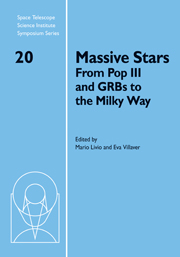Book contents
- Frontmatter
- Contents
- Participants
- Preface
- High-mass star formation by gravitational collapse of massive cores
- Observations of massive-star formation
- Massive-star formation in the Galactic center
- An x-ray tour of massive-star-forming regions with Chandra
- Massive stars: Feedback effects in the local universe
- The initial mass function in clusters
- Massive stars and star clusters in the Antennae galaxies
- On the binarity of Eta Carinae
- Parameters and winds of hot massive stars
- Unraveling the Galaxy to find the first stars
- Optically observable zero-age main-sequence O stars
- Metallicity-dependent Wolf-Rayet winds
- Eruptive mass loss in very massive stars and Population III stars
- From progenitor to afterlife
- Pair-production supernovae: Theory and observation
- Cosmic infrared background and Population III: An overview
An x-ray tour of massive-star-forming regions with Chandra
Published online by Cambridge University Press: 04 August 2010
- Frontmatter
- Contents
- Participants
- Preface
- High-mass star formation by gravitational collapse of massive cores
- Observations of massive-star formation
- Massive-star formation in the Galactic center
- An x-ray tour of massive-star-forming regions with Chandra
- Massive stars: Feedback effects in the local universe
- The initial mass function in clusters
- Massive stars and star clusters in the Antennae galaxies
- On the binarity of Eta Carinae
- Parameters and winds of hot massive stars
- Unraveling the Galaxy to find the first stars
- Optically observable zero-age main-sequence O stars
- Metallicity-dependent Wolf-Rayet winds
- Eruptive mass loss in very massive stars and Population III stars
- From progenitor to afterlife
- Pair-production supernovae: Theory and observation
- Cosmic infrared background and Population III: An overview
Summary
The Chandra X-ray Observatory is providing fascinating new views of massive-star–forming regions, revealing all stages in the life cycles of massive stars and their effects on their surroundings. I present a Chandra tour of some of the most famous of these regions: M17, NGC 3576, W3, Tr14 in Carina, and 30 Doradus. Chandra highlights the physical processes that characterize the lives of these clusters, from the ionizing sources of ultracompact H II regions (W3) to superbubbles so large that they shape our views of galaxies (30 Dor). X-ray observations usually reveal hundreds of pre-main sequence (lower-mass) stars accompanying the OB stars that power these great H II region complexes, although in one case (W3 North) this population is mysteriously absent. The most massive stars themselves are often anomalously hard x-ray emitters; this may be a new indicator of close binarity. These complexes are sometimes suffused by soft diffuse x-rays (M17, NGC 3576), signatures of multi-million-degree plasmas created by fast O-star winds. In older regions we see the x-ray remains of the deaths of massive stars that stayed close to their birthplaces (Tr14, 30 Dor), exploding as cavity supernovae within the superbubbles that these clusters created.
Revealing the life cycle of a massive stellar cluster
High-resolution x-ray images from the Chandra X-ray Observatory and XMM-Newton elucidate all stages in the life cycles of massive stars—from ultracompact H II (UCHII) regions to supernova remnants—and the effects that those massive stars have on their surroundings.
- Type
- Chapter
- Information
- Massive StarsFrom Pop III and GRBs to the Milky Way, pp. 60 - 73Publisher: Cambridge University PressPrint publication year: 2009
- 3
- Cited by

